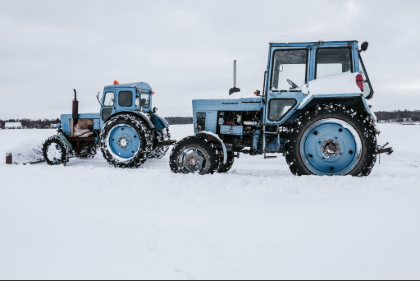INDEPENDENT DEALER
Jackson, WY | (307) 413-6480
OUR BLOG
As Wyoming ranchers know, brutal winter conditions demand serious preparation. AMSOIL: Vaughan Distributing in Jackson, WY, helps you winterize ranch equipment and protect it through the coldest months ahead.

Wyoming's extreme winter conditions present unique challenges for ranch equipment. With temperatures frequently dropping below zero and severe wind chills that can damage exposed components, proper winterization becomes essential for maintaining operational efficiency.
Contact Vaughan Distributing in Jackson, WY at (307) 413-6480 or visit AMSOIL's online store to ensure your cooling system stays protected with premium antifreeze products like AMSOIL Heavy-Duty Antifreeze & Coolant designed for Wyoming's extreme temperature swings.
1. Start with Complete Fluid Changes Before the Freeze
The foundation of any successful winter preparation begins with comprehensive fluid maintenance. To properly winterize ranch equipment, drain all summer-grade fluids and replace them with winter-formulated alternatives. Conventional oils lose viscosity in extreme cold, making engine starts difficult and potentially damaging.
Key fluid changes needed:
- Motor oil - Switch to synthetic that flows at -50°F
- Hydraulic fluid - Use winter-grade to prevent sluggish operation
- Transmission fluid - Replace with cold-weather formulation
- Differential oil - Don't forget these often-overlooked components
Synthetic motor oils maintain their flow properties, ensuring reliable cold-weather starts. This characteristic is especially valuable for Wyoming ranchers who need operating equipment regardless of weather conditions.
2. Protect Your Engine Cooling System from Devastating Freeze Damage
Wyoming's high elevation and dramatic temperature fluctuations necessitate careful cooling system maintenance—test antifreeze concentration using a quality hydrometer to ensure a minimum 50/50 protection.
Critical cooling system checks:
- Test antifreeze strength with a hydrometer
- Inspect all hoses for cracks or soft spots
- Replace worn clamps and connections
- Flush system if over two years old
- Check radiator cap seal integrity
Replace any hoses showing deterioration before winter conditions exacerbate these weaknesses. Clean coolant passages ensure optimal heat transfer and prevent engine damage during cold-weather operation.
3. Battery and Electrical System Preparation Prevents Dead Equipment
Cold weather significantly impacts battery performance. A battery providing 100% capacity at 80°F delivers only 40% of its rated power at zero degrees. Load test all batteries to identify marginal units before cold weather arrives.
Essential electrical system maintenance:
- Load test batteries - Replace any below 12.4 volts
- Clean terminals with a baking soda solution
- Apply dielectric grease to prevent corrosion
- Test block heaters for proper operation
- Inspect all power cords for damage
- Verify battery warmer functionality
These systems prove invaluable during extreme cold but require verification before winter arrives.
4. Implement Smart Storage Strategies for Seasonal Equipment
Equipment remaining idle through winter requires specific preparation procedures. Proper storage prevents costly spring repairs and ensures equipment starts when needed.
Storage preparation checklist:
- Fill fuel tanks completely to prevent condensation
- Add quality fuel stabilizer to all fuel
- Run engines to circulate treated fuel
- Park equipment facing away from prevailing winds
- Cover exhaust pipes and air intakes
- Remove batteries for indoor storage
Indoor storage provides optimal protection for tractors in extreme cold. When outdoor storage becomes necessary, these steps minimize weather damage.
5. Maintain Air Intake and Filtration Systems
Wyoming's winter conditions often include blowing dust and snow that challenge filtration systems. Carefully inspect air filters for any damage that could admit contaminants.
Air system maintenance priorities:
- Replace any damaged air filters immediately
- Check intake boots for cracks or brittleness
- Tighten all clamps and connections
- Install pre-cleaners for severe conditions
- Seal any gaps in air boxes
These devices remove moisture and large particles before they reach primary filters, extending filter life and providing additional engine protection.
For comprehensive farm equipment maintenance for winter, call Vaughan Distributing in Jackson, WY at (307) 413-6480 or visit AMSOIL's online store to find specialized filtration products that protect engines in harsh conditions.
6. Tire and Track Maintenance for Winter Traction
Monitor tire pressures closely during cold weather. Tires lose approximately 1 PSI for every 10°F temperature decrease. Under-inflated tires wear prematurely and provide reduced traction on ice and snow-covered surfaces.
Winter tire and track checklist:
- Check pressures weekly in cold weather
- Inspect tire chains for damage
- Apply a light oil coating to prevent chain rust
- Adjust track tension for cold temperatures
- Verify proper tire tread depth
- Store spare chains accessibly
Follow manufacturer specifications for cold-weather track adjustment to prevent damage to expensive undercarriage components.
7. Grease Everything That Moves
Standard grease becomes ineffective in extreme cold, failing to flow properly or provide adequate lubrication. Convert to a low-temperature synthetic grease formulated specifically for cold-weather applications.
Critical greasing points:
- Loader pivot pins and bushings
- Three-point hitch connections
- PTO shaft assemblies
- Steering components
- Wheel bearings
- Driveline U-joints
Cold-weather operation places additional stress on these components, making proper lubrication critical for preventing premature wear.
8. Create Your Winter Emergency Kit
Equip each piece of machinery with comprehensive emergency supplies. Include spare synthetic oil for agricultural machinery, replacement filters, drive belts, and hydraulic hoses sized for your specific equipment. Add emergency heat sources, recovery equipment, and basic hand tools.
Maintained detailed service records that were accessible from each machine. During cold-weather breakdowns, quick reference to recent maintenance helps diagnose issues efficiently. Document all fluid changes, filter replacements, and component repairs.